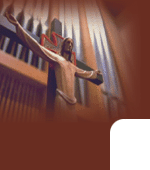

A Brief History of the Friars in Wexford
According to tradition
the Franciscan Friars first arrived in Ireland during the lifetime of
St. Francis of Assisi. There is documentary evidence that they were in
Ireland in 1232. Hore, in his History of Wexford, dates the Friary as
early as 1230, but 1240 seems a more likely year. A small chapel and
cemetery set aside for the Knights Hospitallers of St. John were given
to the Friars by the first Maurice Fitz-gerald as the start of their new
foundation, which was situated just outside the walls of the town.
In I534 King Henry VIII had himself proclaimed, by Act of Parliament,
supreme head of the Church in England. In I536 he summoned an Irish
Parliament, and this Parliament declared King Henry the supreme head of
the Church in Ireland.
In dire need of money Henry set about confiscating church property. The
Wexford Friary was declared confiscated in 1540, and the Friars sought
refuge among their friends and benefactors in the town. In 1560, during
the reign of Queen Elizabeth I there is a reference to the effect, that
the Wexford Friary is now "despoiled and torn down by the Heretics."
Between 1540 and 1622 (when the Friars regained possession of the ruins
of the Friary) the Friars were living in a house in Back Street, and
were secretly ministering in a little chapel built in the yard of the
present Printing Works of the "People Newspapers.ˇ± From 1622 until 1649
the Friars used a temporary shelter and chapel on the site of the ruined
Friary.
In 1654 four more Franciscans were captured and hanged without trial in
the neighbourhood of the Friary. And in 1655, two secular priests,
Father Daniel OˇŻBrien, Dean of the Diocese, and Father James Murphy,
and a Cistercian-Father Luke Bergin, were executed. All were buried in
the ruins of the Friary. Oliver Cromwell died in 1658.
 |
The Cromwellian
massacre of Wexford took place on Thursday, 11th October, 1649.
Seven Friars were among the several thousands of Wexfordians who
were killed by Cromwell's soldiers on that day. The persecution
continued, and in a letter written by Dr. Nicholas French,
Bishop of Ferns, dated 1653, we read. "...Out of 80,000
Catholics in the diocese, there are now 18,000; and in Wexford
town where there were easily 18,000 Catholics, there are now
only 50."
About 1672, Dr. Wadding, opened a thatched Chapel for Catholic
worship in High Street. In 1688 the Friars once again regained
possession of the ruins of their Friary, and by 1691 they had
built a fairly large church. In this latter year Bishop Wadding
was refused permission to repair the church in High Street
because it was inside the walls of the town; and because the
Friary was outside the walls, the official religious services of
the parish began to be held there. |
The present Convent and
Library were built in 1803 by Father Richard Walsh, O.F.M., Guardian,
who journeyed to Belgium and succeeded in tracing and purchasing back
many of the books and manuscripts scattered throughout Belgium at the
time of the suppression of St. Anthony's College, Louvain, 1794. The
Transept was added to the Church in 1832, and in 1875 the present tower
was erected at the north gable of the Transept.
Copyright © 2006 [Wexford Parish]. All rights reserved.